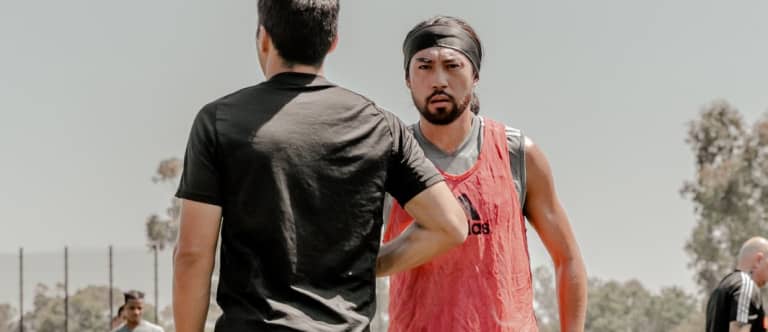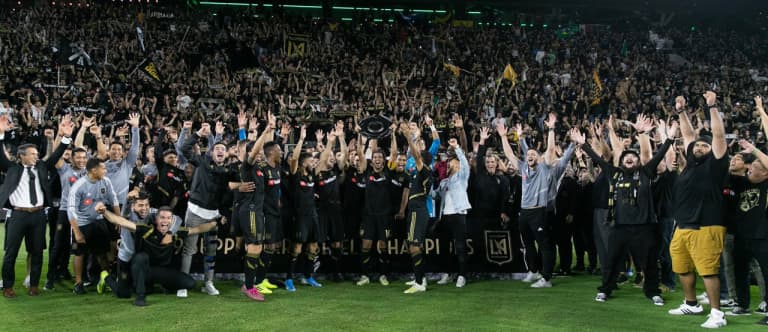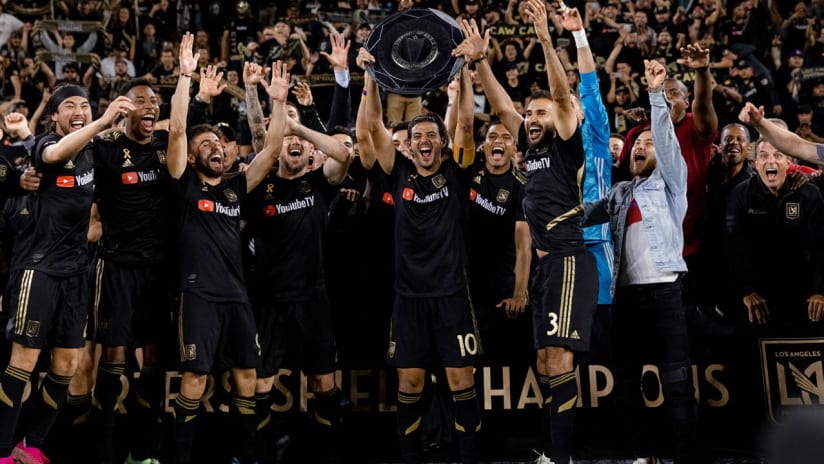LOS ANGELES — Recently crowned 2019 MLS Supporter’s Shield Champions LAFC have plenty of obvious factors that explain their success on the field.
There’s the roster, which includes Best XI candidates all over the field, including a potential Landon Donovan MVP-winning performance from Carlos Vela. There’s the coaching staff, led by Bob Bradley and a team of assistants that has already produced one MLS head coach, Vancouver’s Marc Dos Santos.
There’s Banc of California Stadium, a modern venue in the heart of the city with almost theater-like intimacy, and with the 3252, a constant chorus of raucous support.
All these things have played a significant role in the Black & Gold setting the all-time points record and producing arguably the best league campaign in MLS history.
But while the supporters, venue, players and coaches have righty earned their year-long praise, there are several less-heralded reasons behind the scenes for the club’s stunning 2019 season. Ahead of LAFC’s monumental Audi 2019 MLS Cup Playoffs clash with city rivals LA Galaxy on Thursday (10:30 pm ET | ESPN, ESPN Deportes in US; TSN4, TVAS), MLSsoccer.com had the chance to sit down with the people that help make LAFC tick, and see what goes into making a record-setting club:
Speaking Each Other’s Language
Like all major teams across world soccer, players arrive at LAFC from a number of different countries with their own individual and collective concerns that need to be addressed before they feel settled and ready to perform. Team coordinator Mitchell Monihan, alongside team administrator Geoff Huber, are often the two point people at the frontlines of getting players assimilated into the life in Los Angeles.
Helping players weigh options for housing, geography and getting visas settled are all par for the course with onboarding players but LAFC’s proximity to Cal-State LA — the training facility is adjacent to the campus — has played a major role in addressing one of the core barriers to creating team harmony on and off the field.
“We've been working with the university to try and get classes set up for Spanish speakers to learn English, but also to get the ability for our English speakers to learn Spanish because it goes both ways," Monihan said, mentioning Eduard Atuesta — who arrived with very limited English and recently conducted his first English interview with media — as well as Brian Rodriguez and Diego Rossi as players currently taking English lessons organized by the club.
Meanwhile, midfielder Mark-Anthony Kaye is actively working on his Spanish, going as far as keeping a language journal of new and useful terms. Monihan expects more players will follow suit on both sides of the English/Spanish divide next season.
“They approached us saying they wanted to do it,” he said. “We’re never going to force someone to do something they don’t want to do. We can just say we suggest that this will be extremely helpful, not only being here in Los Angeles, but in life, being able to speak multiple languages will help you out, so just giving them that idea that this will help not only here but in the future and if you want to do it, were going to give you the best resources to get that done.”
Video With Purpose
Whether it’s using a Gerard Pique clip to help center backs better understand defensive reactions during transitions or helping LAFC’s outside backs with offensive marking, video at LAFC’s performance center is no casual matter, especially as it pertains to training.
“Everything that we look at in video revolves around Bob’s game model,” said LAFC’s video analyst, Carlo Valladares. “We are a team that’s very proactive in our football. I know a lot guys in our dressing room have come from teams that are more reactive. What I mean by reactive is that they will train in a way that just nullify the opponent's strengths. …
“Here we focus solely on what were good at and just try to do it better because we feel that we have the quality combined with the idea that it doesn’t matter who comes on the field against us, there is no reason for us to change our football, because we are that confident in our football.”
Valladares counts himself among the ‘real nerds of the game’ and was handpicked by Bradley after the LAFC boss saw his video analysis portfolio of Europe’s top five leagues online. It follows that between seasons one and two of LAFC, there’s been a greater emphasis on showing players video clips from Barcelona and, more recently, Jurgen Klopp’s Liverpool in addition to their own games, training and opponents' matches.
“It’s video with purpose,” explained defender Jordan Harvey. "It’s not just going over goals against where it’s like, ‘This guy could have done better here,’ it’s like actually dissecting it and establishing these principles that Bob preaches that go into our day in day out routine and practice and then implementing those into the games. Everything has a purpose. They aren’t fluff. It’s to a point. It’s about something real."
His teammate and fellow MLS veteran Lee Nguyen agreed.
“The film sessions we do probably are on another level,” said the midfielder, who spent six years in New England prior to joining LAFC in 2018. “I don’t think any team in the league probably does as much film sessions as we do.”
Trusting Injury Principles
Carlos Vela's injury vs. LA was initially cause for concern among the LAFC faithful.
When Vela went down just after drawing his side level at 3-3 with the Galaxy in August, the heart of an entire Black & Gold nation got lodged in its throat. Smelling blood in the water against their rivals, LAFC's captain threw down his armband in frustration at being taken off the field. But more important was what was at stake for the season as a whole.
"Our business is about risk management,” says LAFC’s performance director, Gavin Benjafield. “How risky would it have been to continue [Vela] playing? Yes, high, because there was an injury there. Could he have continued? Most likely but he just would have been doing more and more damage.”
Ultimately Vela’s injury only kept him out for three games — fewer than originally expected, according to Benjafield — but both the choice to bring him off and the recovery that kept the MLS Golden Boot leader in contention to break the all-time single-season goal record, came from principles Benjafield and his staff adhere to when it comes to injuries as well as trust in relationships between performance staff and players.
"At the end, it worked out so [Vela’s] getting dividends for the decision that was made on that day. Building of that trust is a day-by-day process," said Benjafield. "You could get a hamstring protocol printed out but the teams that do it successfully aren’t the teams that run [an injury protocol], they're the teams that know their athlete best. How does that athlete respond best? What triggers? Does he need to get pushed today? Does it need to be a little bit easier today? How do you know what he’s going to go and do? Where is he now and how do you build this kind of step approach? Guys that do nothing with the team and then all the sudden get thrown into the deep end, yes you're throwing a huge risk involved in that. We take calculated risks."
Training Harder & Smarter

High-intensity training has helped midfielder Lee Nguyen tremendously come game time. | Courtesy of LAFC
They say you practice how you play but at LAFC this has been tweaked in a couple of important ways. First, they actually ratchet up the intensity in training.
“In essence, we sometimes do drills whereby the intensity is higher than the game,” said Harry Routledge, PhD, LAFC’s sport science & nutrition specialist. “If we can train at an intensity that’s higher than the game, the game becomes easier then, or the physiological output of the game becomes easier.”
Of course, this approach isn’t always what players who come in are used to and it can lead to some setbacks. In fact, when center back Walker Zimmerman joined LAFC last year, it turned his usual training regimen upside down.
“[Zimmerman] came from Dallas where the game style very much sit back, no press. When obviously Walker came in and understood the game style and he got injured a couple times because the game style was so different,” Routledge said. “Over time, he understands now that when we get into extra running it’s not because we want you to run but he goes, when I do that and when I build that tolerance to a specific amount of load, the game because easier.”
Players like Nguyen who haven’t always been in the starting XI this season have, at times, been given extra running to do off-site to help them stay ready when their name is called.
“It’s really tight,” Nguyen said. “You have to think a lot more. The game is actually a lot faster in these training sessions than in the game. For me, I love it, because then when you get into the game everything seems more spread, more slow.”
On the staff side, it’s all about balancing what players are saying with what the numbers are saying.
“Sometimes hard [to know how the level to push training] but that’s where the science comes into it,” Routledge said. “Understanding that maybe today is not the right day to do that, or this week’s not the right week to do that because we’ve had travel, we’ve had two games in the past week.”
Training intensity isn’t the only place where the club leans on science and data. Just ask the club’s performance analyst, Max Odenheimer, who believes he works closer with the coaching staff than many in his burgeoning field. That’s by design.
“I think a lot of the time, analysts when I talk to them on other teams, are a little bit divorced from the main ship, but Carlo [Valladares] and I are in the room every morning with the coaches. We’re sitting with them for three hours in the morning, we are with them after practice, I feel like we have a really strong idea of what they need from us and how we want to play. I think that’s incredibly important and it runs through our work.”
Big Staff, Professional Integration
Language lessons, visas, housing, injury prevention, training loads, data for it all — there are a lot of moving pieces to a club’s on-field play. While the individual parts are far from unique to the Suppers' Shield winners, at LAFC it’s the way it all fits together that matters most.
“Nothing we do is separate,” Bradley said earlier this season. “The things that we do have to all fit together.”
That becomes all the more essential when you’re talking about a staff the size of LAFC’s — more than a dozen full-time employees are in the soccer operations side alone. But how does that actually come together?
It starts with the architect.
“It’s to hire the best coach in MLS,” said Odenheimer of Bradley. “As a standard bearer, as a leader, I don’t think you could really have someone who is better, has more experience, has seen more things and has range, has an understanding of almost every facet of an organization and an understanding of the standards he wants the rest of the staff to hit.”
The boss deflects that same praise back on his guys.
“We want to be as professional as possible,” said Bradley. “Between sports science and the work that gets done in the gym and then how that relates to warm-ups on the field and different kinds of movements, I think all those things are done well. Those things are all connected within what the physical load is in training, how you build a week, how you create a month, or a bigger period. You use everything possible to do those things right and I think that we’ve got a lot of really good people.
“We work together with excellent communication and we challenge each other, so for me, that part’s great. … There’s still areas where we think we can get better but I would emphasize that the communication and the collaboration inside with everything I think is top-notch.”
A Consistent Message

LAFC will try to raise the bar further after their record-setting Supporters' Shield win. | Courtesy of LAFC
After year one ended with a first-round playoff loss, club president Tom Penn had one message for year two of LAFC: “Get Better.” On the field, whether it was seeing the midfield trio of Kaye, Atuesta and Latif Blessing individually and collectively find another gear, Vela and Rossi hit career highs in terms of numbers, or new players being integrated seamlessly, those two words became the rallying call across many departments of the club, including those at the performance center.
“I’m already asking our own guys. ‘Hey, if budget were an issue what could we do that would make us better? If budget were not an issue what could we do to get better?,’” said Benjafield. “So we’re planning on what next year would look like and we’re not going to throw the baby out with the bathwater altogether, but we are certainty going to go: ‘We’ve reached this level, what can we do next?’”
For a new club, there are several obvious areas the team is already looking to improve for 2020. Nutrition is one such item on that list.
“It’s not rocket science,” Routledge said, discussing carbohydrate periodization, electrolyte drinks, and a general lack any special diet. “It’s just simple smart nutritional practices, its what’s in the research. It’s what my education background, a lot of it, was on.”
Having a PhD like Routledge on staff to help is one thing, but getting players’ families on board with the nutritional plans will help make sure the players are making better decisions for fuel when they leave the LAFC grounds.
There is another key part of LAFC’s plans that has yet to truly make its impact felt on the first-team’s performances: the academy. Having already collected several important trophies of its own and consistently ranked among the best in MLS despite starting from the ground up with the a group of U-12s years before the club entered the league, the academy is set to be key as LAFC look make their first team even better in the years to come.
Not content with just mirroring the best, LAFC will look to improve on one of the world’s most-famed academy systems at Ajax Amsterdam. Benjafield had a spell at the Dutch giants and feels as much as that club is all about bringing a player up through the system, there were still ways to improve the model, namely in adjusting how young players at clubs like Ajax often need to change environments as they work to integrate with the first-team setup.
“You don’t get that same sense over here,” Benjafield says of the way LAFC is treating its academy. “Everyone is pointed in the same direction and wanting the best for the player and putting the payer central in there. How do we get better? Continue what we’re doing and make sure that we remain integrated, inter-department as well as academy and first team.”
Steven Beitashour, an MLS Cup winner in 2017 with Toronto FC and now a Supporters’ Shield winner with three different teams, summed up what all the “Getting Better” striving feels like in terms of day-in-day-out effort — not just for the players, coaches, but the whole of the LAFC organization.
“It is [more work] but it doesn’t feel like it.














